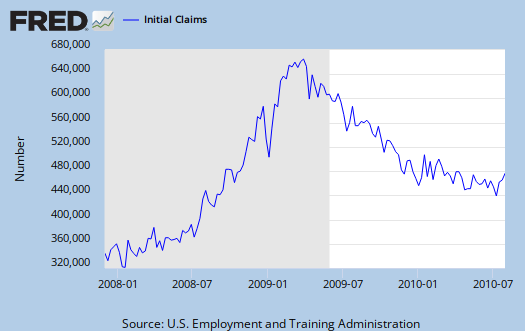The financial headline buzz du jour is all about initial weekly unemployment claims, which increased by 19,000. Why the U.S. jobs crisis is suddenly alarming news, when we and many other economic blogs have been sounding the alarm for years, is anybody's guess. Last week we showed, initial unemployment claims are simply too high and have stayed that way for months. Another alarming sign is the Challenger & Gray Job Cut report. Announced layoffs rose 6% from last month, the 3rd month in a row announced layoffs increased.
So far this year, the government and non-profit sector has announced 105,969 job cuts, nearly triple the next largest job-cutting sector: the pharmaceutical industry, which has announced 37,010 job cuts, 30 percent fewer than at this point last year.
While the 6% mass firing increase still comes nowhere near the 2008 and 2009 planned layoff announcements, the report gives some clues as to what is really going on in the U.S. While Challenger & Gray now list jobs lost due to offshore outsourcing, the reality is these job losses are often hidden as restructuring and cost cutting, wrongly attributed. Corporations do not announce offshore outsourcing most of the time. They do not like the press. Reading between the lines of the Challenger& Grey report, there is a clear pattern of offshore outsourcing of U.S. jobs. For example, obviously the pharmaceutical industry is not hurting, profit wise. They are offshore outsourcing research and development as well as clinical trials and have been doing so, in a mass job exodus, since 2005. Computers and Telecommunications are touted often as having a worker shortage. Yet they come in 3rd and 4th in terms of announced planned layoffs. The Science & Technology business sectors have been committing labor arbitrage against U.S. workers for over a decade.
Below are St. Louis Federal Reserve graphs on this weeks initial unemployment claims.

The advance figure for seasonally adjusted initial claims was 479,000, an increase of 19,000 from the previous week's revised figure of 460,000. The 4-week moving average was 458,500, an increase of 5,250 from the previous week's revised average of 453,250.
A general rule of thumb is weekly initial unemployment claims need to drop below 400,000 for job growth to occur.
Below is the log of the initial unemployment claims 4 week average for a decade. By using logs, we create a noise filter on weekly initial claims to see the change over time. As you can see, it appears weekly initial claims have found their bottom and are staying there. The average bottom is above the level, and staying above the level of weekly initial claims we need for job creation.

Nuf said, corporations are busy creating jobs in India, China and elsewhere, all the while leaving the U.S. worker in financial ruins.

Shhhh...
Please don't let anyone know where jobs are being created. We're all supposed to be too stupid to notice...